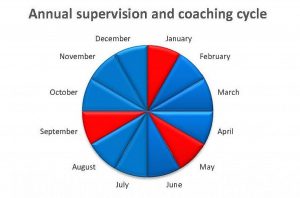 One of the questions people raise frequently is how you can coach those you also supervise. My observation as I’ve reflected on how people lead is they over-supervise and under-coach. The more you wear the supervisor hat, the more you create the temptation to micromanage. A supervisor needs to hold the person accountable for results, work toward agreement on goals, and evaluate progress. A coach, on the other hand, needs to draw out and help support the person’s own ideas. The first step is to separate the coaching from the supervision. If you try to do them both in the same session, it gets muddled and you often don’t get accomplished what you want to accomplish. So begin by separating supervision meetings from coaching meetings. For staff-level people, you probably only need to have three supervisory meetings per year. Every four months, they can come prepared to share what’s been accomplished in the last four months. They can also provide their priorities and specific goals for the next four months. The supervisor of course has the chance to speak into that, and also give a performance review. Between your every four month supervision appointments is where you want your 3 coaching conversions. Those coaching conversations come with the agenda because the staff-member already knows what they are trying to accomplish. The task at hand now is processing and determining what kind of help or support is needed.
One of the questions people raise frequently is how you can coach those you also supervise. My observation as I’ve reflected on how people lead is they over-supervise and under-coach. The more you wear the supervisor hat, the more you create the temptation to micromanage. A supervisor needs to hold the person accountable for results, work toward agreement on goals, and evaluate progress. A coach, on the other hand, needs to draw out and help support the person’s own ideas. The first step is to separate the coaching from the supervision. If you try to do them both in the same session, it gets muddled and you often don’t get accomplished what you want to accomplish. So begin by separating supervision meetings from coaching meetings. For staff-level people, you probably only need to have three supervisory meetings per year. Every four months, they can come prepared to share what’s been accomplished in the last four months. They can also provide their priorities and specific goals for the next four months. The supervisor of course has the chance to speak into that, and also give a performance review. Between your every four month supervision appointments is where you want your 3 coaching conversions. Those coaching conversations come with the agenda because the staff-member already knows what they are trying to accomplish. The task at hand now is processing and determining what kind of help or support is needed.  In this way, you’re working 75% of your time in a developmental mode, and 25% of your time in supervision mode. So what I’m suggesting—and what has been working well– is to create this type of rhythm: Schedule 3 supervisory appointments per year: January, May, and September. Functionally, you’re on a trimester system. In between supervision appointments, schedule those 9 monthly coaching appointments. During the coaching appointments, be sure you’re clearly wearing the coaching hat and the agenda is totally their prerogative. They already know what they’re supposed to be accomplishing; they have clarity on what they’re responsible for. During these sessions, they determine what is most helpful to process with you. Instead of giving advice or directives, ask, “So what have you already thought of?” Unpack their answers fully before giving any input. You don’t need to do their thinking for them. They are not looking to you for answers. They are responsible for their own thinking and actions to do what needs to be done. By your holding a very clear coaching posture, you can help them use these times more effectively. Try it and see how it works!
In this way, you’re working 75% of your time in a developmental mode, and 25% of your time in supervision mode. So what I’m suggesting—and what has been working well– is to create this type of rhythm: Schedule 3 supervisory appointments per year: January, May, and September. Functionally, you’re on a trimester system. In between supervision appointments, schedule those 9 monthly coaching appointments. During the coaching appointments, be sure you’re clearly wearing the coaching hat and the agenda is totally their prerogative. They already know what they’re supposed to be accomplishing; they have clarity on what they’re responsible for. During these sessions, they determine what is most helpful to process with you. Instead of giving advice or directives, ask, “So what have you already thought of?” Unpack their answers fully before giving any input. You don’t need to do their thinking for them. They are not looking to you for answers. They are responsible for their own thinking and actions to do what needs to be done. By your holding a very clear coaching posture, you can help them use these times more effectively. Try it and see how it works!
